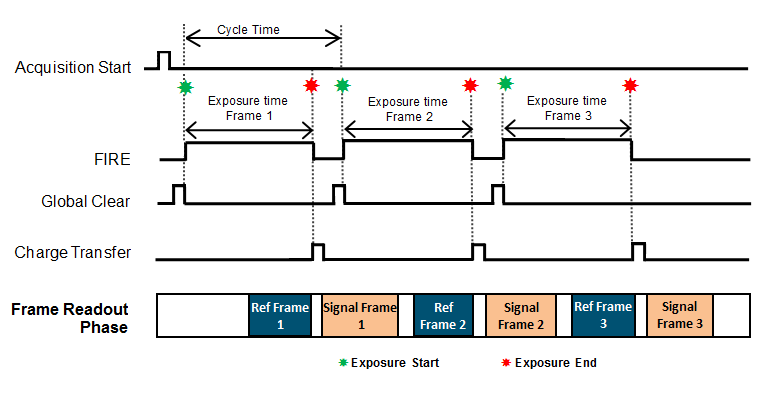Global Shutter Internal Triggering (Overlap Mode)
In Internal Triggering in Overlap Mode, the read out of an exposure overlaps with the next exposure. This allows the user to maximise the Cycle Time for a given exposure time. The absolute maximum frame rate achievable is the time taken to read out both the Reference and Signal Frame from the sensor. As in Non-Overlap Mode, the user has control over the exposure time and cycle time.
In this scenario, the exposure begins by pulsing the Global Clear. The reference frame is read out during the exposure such that the end of the reference read out is coincident with the end of the exposure. The Charge Transfer pulse then goes HIGH to transfer charge from all pixels in the sensor. The signal frame is then read out. During this read out, a new exposure begins by pulsing the Global Clear.

Global Shutter Internal Triggering (Overlap Mode)
Global Shutter Internal Triggering (Overlap Mode) Timing Parameters - Cycle Time Dependency on Exposure
| Parameter | Minimum | Maximum |
|---|---|---|
| Exposure | 1 Frame + 1 InterFrame + 1 Row | 2 Frames + 1 InterFrame |
| Cycle Time (1/Frame Rate) | 2 Frames + 2 InterFrames + 1 Row | 2 Frames + 2 InterFrames +1 Row |
| Acquisition Start Delay | 0 | 1 Row |
| Exposure | 2 Frames + 1 InterFrame + 1 Row | 30 s |
| Cycle Time (1/Frame Rate) | Exposure + 1 InterFrame + 1 Row | 30 s |
| Acquisition Start Delay | 0 | 1 Row |
| Note |
|---|
| The table shows that the cycle time depends on the exposure selected – within the exposure range detailed in the first row the cycle time is constant, however for exposures of (2 Frames + 1 Interframe + 1 Row) or longer the cycle time increases with exposure. |